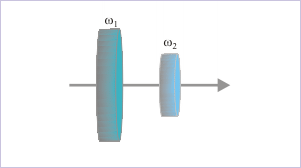| << Chapter < Page | Chapter >> Page > |
However, there is the fact that motions along mutually perpendicular axes are independent of each other. This is an experimental fact, which has been described in detail in the module titled Projectile motion . This independence is a characteristic feature of motion and comes to our rescue in analyzing motion of an isolated system in the context of conservation of angular momentum.
The angular momentum is a vector quantity having direction as well. As such, we can express conservation of angular momentum along three mutually perpendicular axes of a rectangular coordinate system.
Looking at the above formulations, we realize that application of conservation law in three mutually perpendicular directions is a powerful paradigm. Even if external torque is not zero on a system, it is likely and possible that net component of external torques in a particular direction is zero. The component form of the conservation law allows us to apply conservation in that particular direction, irrespective of consideration in other mutually perpendicular directions. This is a great improvisation as far as application of the conservation of angular momentum is concerned. We, therefore, can state the component form of the law :
Isolated body system is a special case of general conservation law of angular momentum. It may occur to us that the rotational description can very well be analyzed in terms of Newton's second law. Why do we need to consider such eventuality for conservation of angular momentum? As pointed out early in this module, there are situations of rigid bodies, which are capable to change their mass distribution and it would be very difficult to analyze motion in terms Newton's second law of motion. Conservation law, on the other hand, can elegantly provide the solution.
Humans are one such body. We can change our body configuration by manipulating arms and legs. This is what dancers, skaters and spring board divers do. They change their body configuration, while in motion. This changes their moment of inertia about the axis of rotation. However as there is no external torque involved, there is corresponding change in their angular velocity to conserve angular momentum of the body system.
There is yet another situation, when conservation of angular momentum for body system can be helpful in analyzing motion. We can consider multiple parts of the body system which may selectively undergo rotation about a common axis of rotation. For example, motions of two discs along a common spindle can be analyzed by considering conservation of angular momentum of the isolated body system.
System of two disks


Notification Switch
Would you like to follow the 'Physics for k-12' conversation and receive update notifications?